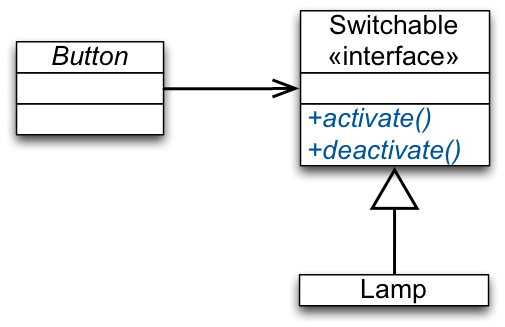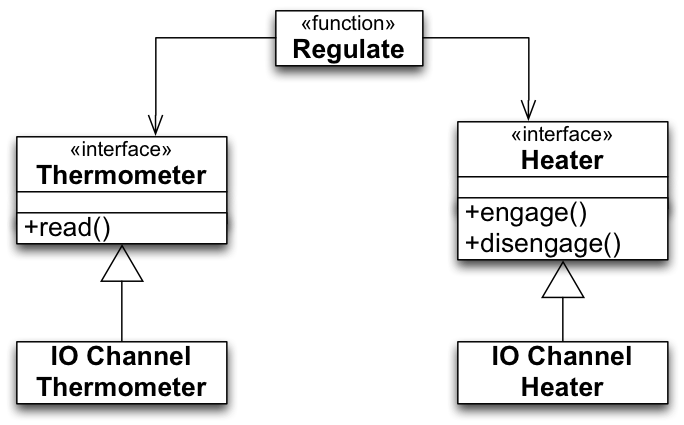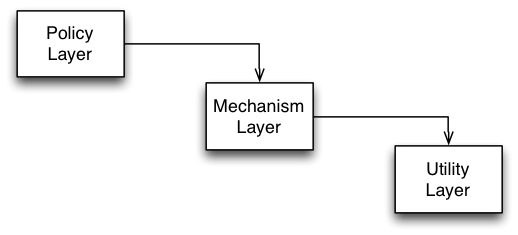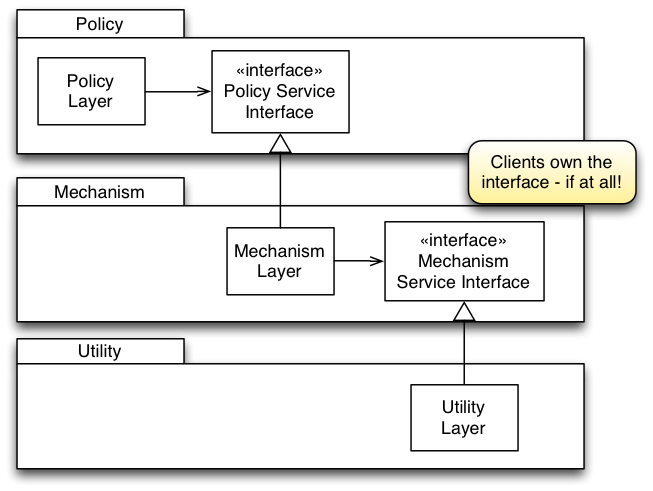Dependency Inversion Principle (DIP)
Example
Assessment:
- We cannot reuse
Buttonsince it depends directly onLamp. (But there are plenty of other uses forButton.) Buttonshould not depend on the details represented byLamp.
These are symptoms of the real problem (Violation of the Dependency-Inversion Principle).
The high-level policy (detection of on/off gestures) underlying this (mini) design depends on the low-level details.
The underlying abstraction is the detection of on/off gestures and their delegation to a server object that can handle them.
If the interface of Lamp is changed, Button has to be at least tested or even adjusted, even though the policy that Button represents is not changed!
To make the high-level policy independent of details we should be able to define it independent of the details of Lamp or any other specific device.
Now Button only depends on abstractions; it can be reused with various classes that implement Switchable.
Changes in Lamp will not affect Button.
The dependencies have been inverted: Lamp now has to conform to the interface defined by Button.
Actually: both depend on an abstraction!
The Rationale behind the Dependency-Inversion Principle
High-level policies and business processes is what we want to reuse. If high-level modules depend on the low-level modules changes to the lower level details will force high-level modules to be tested again/to be changed. Additionally, it becomes harder if not practically impossible to use them in other contexts. It is the high-level modules that should influence the low-level details.
Advanced Example
We have three modules where Regulate uses the other two:
Regulatepulls data about the current temperature from theThermometercomponent andRegulatesignals theFurnacecomponent to increase or decrease heat.
Layers and Dependencies
This interpretation clearly violates DIP. Higher-level modules depend on lower-level modules.
This is actually a typical structure of a layered architecture realized with structured programming (e.g., using "C").
- An upper-layer declares (owns) interfaces for services it needs.
- Lower-layer implements these interfaces.
- Upper-layer uses lower-layer by the interface.
The upper layer does not depend on the lower-layer. - Lower-layer depends on the interface declared by the upper-layer.
Usually, we think of utility libraries as owning their own interfaces. (A relict from structured programming era.) Due to ownership inversion, Policy is unaffected by changes in Mechanism or Utility.
Naive Heuristic for Ensuring DIP
This heuristic is usually violated at least once in every program:
- Some class will have to create concrete classes.
- Subclass relationships do often terminate at a concrete class.
The heuristic seems naive for concrete stable classes, e.g., String in Java. But, concrete application classes are generally volatile and you should not depend on them. Their volatility can be isolated by keeping them behind abstract interfaces owned by clients.





